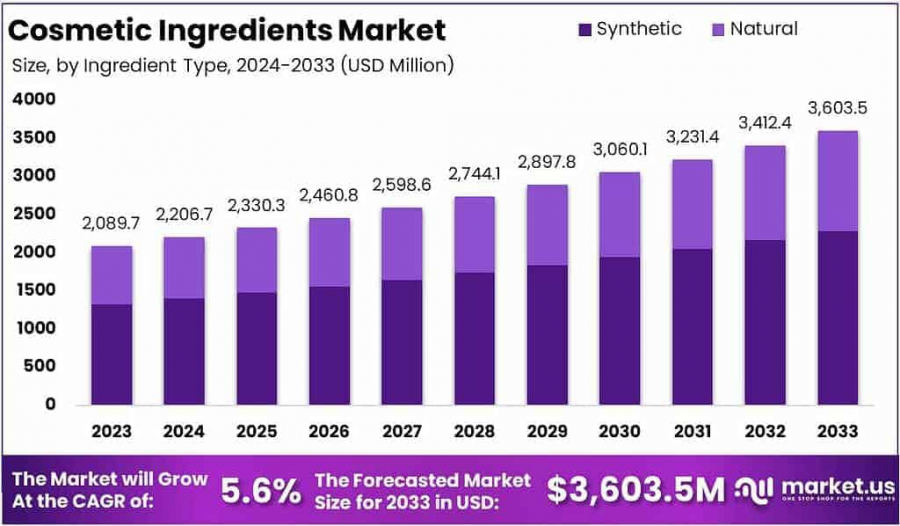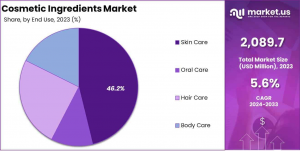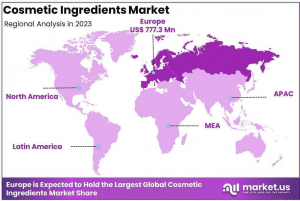
Cosmetic Ingredients Market reach USD 3,603.5 Million by 2033
The Global Cosmetic Ingredients Market size is expected to be worth around USD 3,603.5 Million by 2033, from USD 2,089.7 Million in 2023, at a CAGR of 5.6%
NEW YORK, NY, UNITED STATES, January 22, 2025 /EINPresswire.com/ -- Market Overview
The Global Cosmetic Ingredients Market size is expected to be worth around USD 3,603.5 Million by 2033, from USD 2,089.7 Million in 2023, growing at a CAGR of 5.6% during the forecast period from 2024 to 2033.
The cosmetic ingredients market refers to the diverse range of raw materials used in the formulation of cosmetic and personal care products. These ingredients include active substances, preservatives, emollients, surfactants, fragrances, and colorants, each serving a specific function to enhance product performance, texture, stability, and overall appeal.
The market caters to various sectors such as skincare, haircare, makeup, and fragrances, serving both mass-market and premium product lines. Growing consumer awareness about product formulations and an increasing preference for natural and sustainable ingredients have significantly shaped the demand for cosmetic ingredients.
The cosmetic ingredients market has seen consistent growth driven by rising consumer demand for skincare and haircare products, particularly those formulated with organic and natural ingredients. The growing trend toward clean beauty and eco-friendly formulations has spurred innovation in ingredient sourcing and manufacturing.
Additionally, there is an increasing focus on anti-aging, sun protection, and wellness-driven cosmetic products, which creates substantial opportunities for ingredient suppliers to align with evolving consumer preferences.
Government investment in sustainable production practices, along with regulations ensuring product safety and quality, has further encouraged the growth of the cosmetic ingredients market. Stringent regulatory frameworks such as the EU Cosmetics Regulation and FDA guidelines in the U.S. ensure that ingredients meet high safety standards, fostering consumer confidence.
These regulations also incentivize companies to innovate in developing eco-friendly, non-toxic, and cruelty-free formulations, tapping into a niche market that aligns with consumer values.
For both new entrants and established players, strategic decisions based on comprehensive market insights, such as those provided in this report, can lead to successful business expansion. New companies should focus on adopting cutting-edge technologies, investing in R&D for sustainable ingredient solutions, and tapping into the clean beauty trend to capture consumer attention.
Existing players, on the other hand, should refine their product offerings based on evolving consumer preferences, leveraging regulatory compliance and sustainability to enhance brand loyalty and gain a competitive edge.
Curious About Market Trends? Request Your Complimentary Sample Report Today: https://market.us/report/cosmetic-ingredients-market/free-sample/
Key Takeaway
-The global cosmetic ingredients market is projected to grow from USD 2,089.7 million in 2023 to USD 3,603.5 million by 2033, at a robust CAGR of 5.6% during the forecast period.
-Synthetic ingredients dominated with a 63.5% share in 2023, driven by affordability, availability, and consistent performance in formulations.
-Surfactants led the product category with a 21.4% market share in 2023, owing to their multifunctional applications in personal care formulations.
-Cleansing agents and foamers commanded a 32.5% share in functionality, highlighting their essential role in personal hygiene and skincare routines.
-Skin care dominated the end-use segment with a 46.2% market share, driven by rising consumer demand for anti-aging and hydration-focused products.
-Europe emerged as the leading market with a 37.2% share in 2023, supported by stringent regulatory frameworks, innovation, and sustainability-focused initiatives.
Use Cases
1. Anti-aging Products Development: Cosmetic brands are incorporating advanced anti-aging ingredients like peptides and antioxidants to create products that reduce wrinkles, fine lines, and improve skin elasticity. Ingredients such as hyaluronic acid and vitamin C are gaining popularity.
2. Sustainable and Clean Beauty: Consumers are demanding natural, eco-friendly, and chemical-free products. Cosmetic brands are shifting toward organic ingredients like aloe vera, tea tree oil, and other plant-based components to meet this demand.
3. Skin Tone Enhancing Products: With the growing trend of inclusivity, cosmetic companies are focusing on creating ingredients that cater to diverse skin tones. Ingredients like niacinamide and licorice extract are used to even skin tone and reduce pigmentation.
4. Hair Care Products: Cosmetic ingredients are increasingly being used in hair care products. Nutrients like biotin, keratin, and argan oil are added to shampoos, conditioners, and serums to nourish, hydrate, and repair damaged hair.
5. Personalized Skincare: Advancements in technology have led to personalized skincare solutions. Brands are using data-driven insights to create skincare formulations with specific ingredients tailored to individual needs, such as salicylic acid for acne-prone skin.
Driving Factors
Rising Consumer Awareness of Natural Ingredients: Consumers are increasingly prioritizing natural and organic ingredients in their skincare and beauty products. As people become more conscious about the harmful effects of chemicals in cosmetics, there is a growing preference for products with plant-based or sustainably sourced ingredients. This trend is driving the demand for natural cosmetic ingredients, such as essential oils, plant extracts, and organic compounds.
Growing Demand for Anti-Aging Products: With an aging global population, the demand for anti-aging skincare products is surging. Ingredients such as retinoids, peptides, and antioxidants are in high demand due to their ability to reduce wrinkles, fine lines, and other signs of aging. The cosmetics industry is increasingly relying on these ingredients to meet the demands of aging consumers seeking youthful skin.
Innovation in Cosmetic Formulations: The continuous innovation in cosmetic formulations is a key driver in the growth of the cosmetic ingredients market. Manufacturers are developing new and more effective ingredients that provide better results, such as ingredients that offer enhanced hydration, improved skin tone, or better sun protection. Innovations like probiotics, hyaluronic acid, and biotechnologically sourced ingredients are driving new product offerings in the beauty industry.
Rising Popularity of Men’s Grooming Products: The growing male grooming market is creating new opportunities for cosmetic ingredients. Men are increasingly seeking skincare products designed for their needs, including moisturizers, cleansers, and anti-aging treatments. As a result, there is a rising demand for ingredients tailored to men’s skincare routines, such as soothing agents and oils that work on thicker skin types.
Regulatory Pressure and Safety Standards: As consumer safety concerns increase, there is a heightened focus on the regulatory standards for cosmetic ingredients. Many countries have stringent regulations that require products to be tested for safety and quality before being sold. Manufacturers are increasingly turning to certified, safe, and well-regulated ingredients to meet these standards, thus driving the growth of the cosmetic ingredients market.
Report Segmentation
In 2023, synthetic cosmetic ingredients dominated the global market with a 63.5% share due to their affordability, availability, and consistent performance. Surfactants, crucial for cleansing, foaming, and emulsifying, held a 21.4% share, while cleansing agents and foamers led the market by functionality, accounting for 32.5% of the market. The skin care segment also played a major role, representing 46.2% of the market as consumers increasingly sought anti-aging, moisturizing, and sun protection products, especially with the rise of premium offerings.
By Ingredient Type
~Synthetic
~Natural
By Product Type
~Surfactant
~Emollient
~Polymer
~Oleo-chemical
~Botanical Extract
~Rheology Modifier
~Preservatives
~Antioxidant
~Emulsifier & Stabilizer
~Others
By Functionality
~Cleansing Agents & Foamers
~Aroma
~Moisturizing
~Specialty
~Others
By End Use
~Skin Care
~Oral Care
~Hair Care
~Body Care
Ready to Act on Market Opportunities? Buy Your Report Now and Get 30% off: https://market.us/purchase-report/?report_id=55034
Regional Analysis
The global cosmetic ingredients market shows distinct regional differences, influenced by consumer preferences, regulations, and industry developments. Europe leads the market, holding a strong 37.2% share in 2023, valued at around USD 777.3 million. This dominance is largely due to the region's stringent regulatory standards, such as REACH (Registration, Evaluation, Authorization, and Restriction of Chemicals) and the EU Cosmetics Regulation, which promote the use of high-quality and sustainable ingredients.
Growth Opportunities
1. Rising Demand for Natural Ingredients
Consumers are increasingly looking for cosmetic products with natural, organic, and sustainable ingredients. This shift towards clean beauty" presents an opportunity for manufacturers to develop new, eco-friendly ingredients that appeal to health-conscious consumers.
2. Growth in Anti-Aging Products
With the aging population globally, demand for anti-aging products has surged. Ingredients like peptides, hyaluronic acid, and antioxidants are in high demand as consumers seek products that prevent wrinkles and improve skin elasticity.
3. Increased Awareness of Skin Health
There is growing awareness about skincare and the importance of using the right ingredients to promote skin health. This has led to a boom in ingredients that cater to skin conditions like acne, eczema, and hyperpigmentation, creating opportunities for ingredient suppliers to innovate in these areas.
4. Expansion of Men’s Grooming Market
The men’s grooming sector is growing rapidly, with more men seeking skincare and personal care products. This expanding demographic presents opportunities for ingredients specifically designed for men's skin, such as anti-shine or sensitive skin formulations.
5. Sustainable and Ethical Sourcing
With consumers becoming more aware of sustainability issues, there’s an increasing demand for ingredients sourced ethically and sustainably. Cosmetic ingredient companies can grow by promoting transparency and providing eco-conscious alternatives."
Key Players
~Clariant AG
~Solvay S.A.
~BASF SE
~Dow Chemical Company
~Eastman Chemical Company
~Croda International PLC
~Estee Lauder Company
~Ashland Global Specialty Chemicals
~Lonza Group Ltd.
~Wacker Chemie AG
Not Sure? Request a Sample Report and See How Our Insights Can Drive Your Business: https://market.us/report/cosmetic-ingredients-market/free-sample/
Trending Factors
Rise in Consumer Awareness of Natural Products: Consumers are becoming more health-conscious and are seeking natural, organic, and cruelty-free cosmetic ingredients. There is a rising demand for products free from synthetic chemicals, parabens, and artificial fragrances, which is boosting the growth of plant-based and organic ingredients.
Personalized Skincare & Customization: The increasing trend of personalized beauty is encouraging the use of tailored cosmetic ingredients. Consumers are looking for products that cater to their specific skin types, tones, and concerns, leading to growth in the demand for ingredients that offer custom solutions.
Technological Advancements in Formulation: Innovation in cosmetic ingredient formulation has enabled the development of more effective, long-lasting, and targeted beauty products. Advanced technologies like nanotechnology and biotechnology are being used to create better delivery systems for active ingredients, improving their performance.
Sustainability and Eco-friendly Packaging: Environmental concerns are influencing the cosmetic ingredients market. There is a shift towards sustainable ingredient sourcing and eco-friendly packaging. Many brands are focusing on reducing their carbon footprint, using recyclable or biodegradable packaging, and supporting fair trade practices.
Regulatory Pressure and Safety Standards: As consumer safety becomes a major concern, stricter regulations around cosmetic ingredient safety are being enforced globally. This includes testing for allergens, skin irritation, and overall toxicity. Manufacturers must comply with these regulations, which pushes the market towards more transparent and safe ingredient formulations.
Restraining Factors
1. Stringent Regulatory Requirements The cosmetic ingredients market is heavily regulated, especially in regions like Europe and the U.S. These regulations ensure that the ingredients used are safe for consumers, but they also increase the complexity and cost of market entry. Manufacturers must comply with various standards and testing requirements, which can be time-consuming and expensive, slowing down the market's overall growth.
2. Increasing Consumer Awareness of Ingredients As consumers become more educated about the ingredients in their cosmetic products, there is increasing demand for transparency and ethical sourcing. While this trend benefits some brands, it can pose challenges for manufacturers that are not transparent about their ingredient sourcing or do not meet the standards of clean" beauty. This shift towards natural and organic products may restrain the growth of traditional chemical-based ingredient suppliers.
3. Price Sensitivity in Emerging Markets While there is significant growth in the global cosmetic ingredients market, emerging markets are often more price-sensitive due to lower disposable incomes. The demand for high-quality cosmetic ingredients may be restrained by the affordability of these products. Manufacturers looking to enter these markets need to balance quality with cost-effectiveness, which can be a challenge in competitive environments."
Conclusion
The Global Cosmetic Ingredients Market is on track to expand significantly from USD 2,089.7 million in 2023 to USD 3,603.5 million by 2033, propelled by a CAGR of 5.6%. This growth is underpinned by the rising consumer demand for products incorporating natural, sustainable, and technologically advanced ingredients. As the industry trends toward clean and ethical beauty, companies are poised to capitalize on innovations that meet these evolving preferences. With stringent regulations reinforcing the safety and quality of cosmetic products, companies are incentivized to develop formulations that are not only effective but also environmentally friendly and ethically sourced.
The market's trajectory suggests a continued focus on anti-aging, skin health, and personalized beauty solutions, highlighting the potential for dynamic growth in both traditional and emerging segments. As the market evolves, key players and new entrants alike have significant opportunities to harness the shifting consumer landscape towards more conscious beauty choices, ensuring long-term viability and success in the global market.
Lawrence John
Prudour
+91 91308 55334
Lawrence@prudour.com
Visit us on social media:
Facebook
LinkedIn
Distribution channels: Beauty & Hair Care
Legal Disclaimer:
EIN Presswire provides this news content "as is" without warranty of any kind. We do not accept any responsibility or liability for the accuracy, content, images, videos, licenses, completeness, legality, or reliability of the information contained in this article. If you have any complaints or copyright issues related to this article, kindly contact the author above.
Submit your press release


